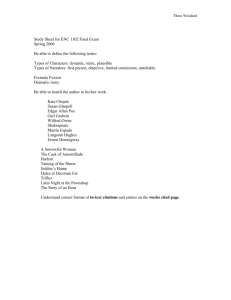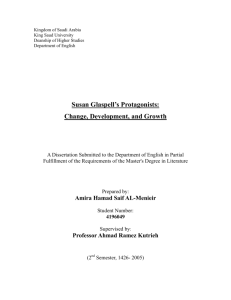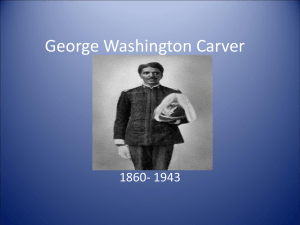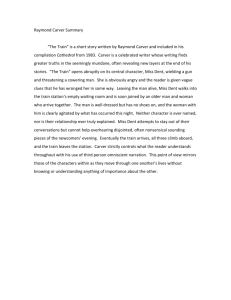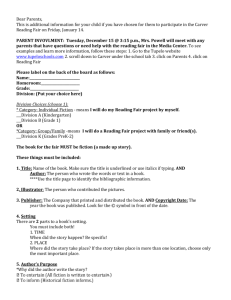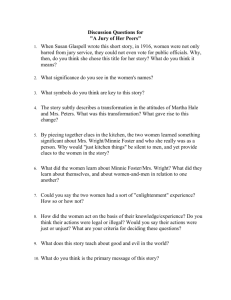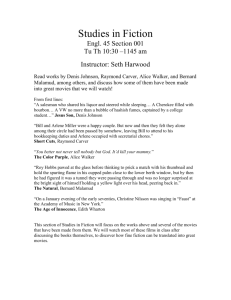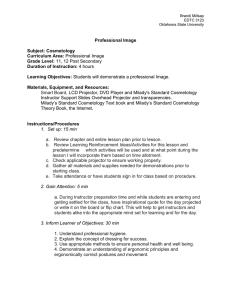Character Roles in Short Stories: Lesson Plan (9-12)
advertisement
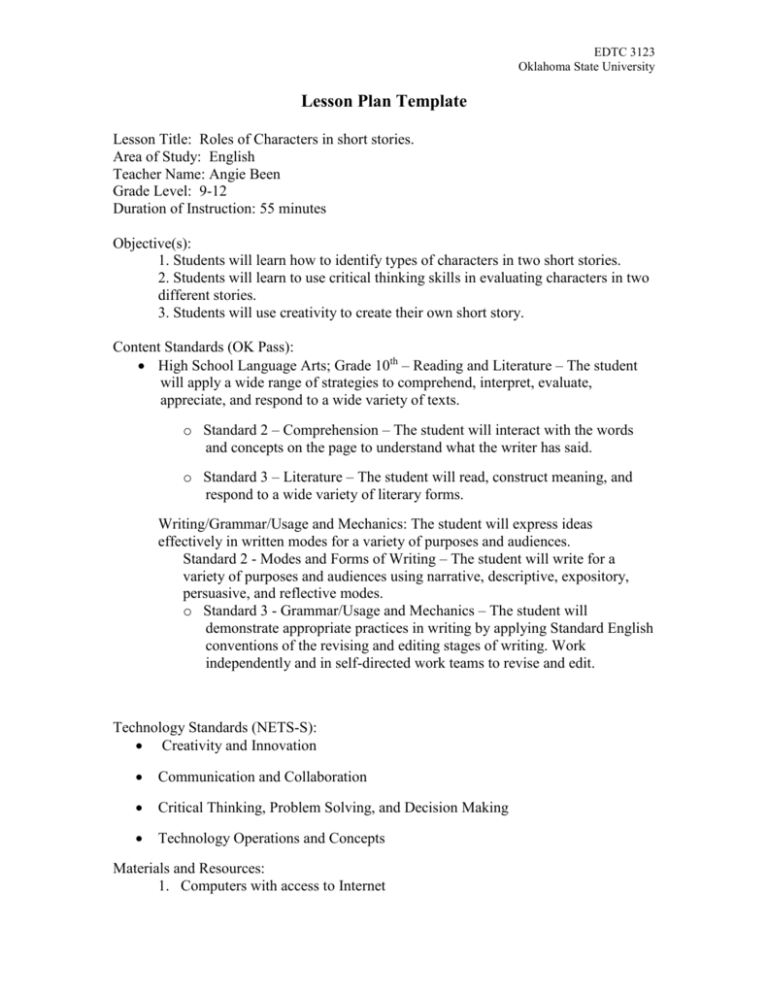
EDTC 3123 Oklahoma State University Lesson Plan Template Lesson Title: Roles of Characters in short stories. Area of Study: English Teacher Name: Angie Been Grade Level: 9-12 Duration of Instruction: 55 minutes Objective(s): 1. Students will learn how to identify types of characters in two short stories. 2. Students will learn to use critical thinking skills in evaluating characters in two different stories. 3. Students will use creativity to create their own short story. Content Standards (OK Pass): High School Language Arts; Grade 10th – Reading and Literature – The student will apply a wide range of strategies to comprehend, interpret, evaluate, appreciate, and respond to a wide variety of texts. o Standard 2 – Comprehension – The student will interact with the words and concepts on the page to understand what the writer has said. o Standard 3 – Literature – The student will read, construct meaning, and respond to a wide variety of literary forms. Writing/Grammar/Usage and Mechanics: The student will express ideas effectively in written modes for a variety of purposes and audiences. Standard 2 - Modes and Forms of Writing – The student will write for a variety of purposes and audiences using narrative, descriptive, expository, persuasive, and reflective modes. o Standard 3 - Grammar/Usage and Mechanics – The student will demonstrate appropriate practices in writing by applying Standard English conventions of the revising and editing stages of writing. Work independently and in self-directed work teams to revise and edit. Technology Standards (NETS-S): Creativity and Innovation Communication and Collaboration Critical Thinking, Problem Solving, and Decision Making Technology Operations and Concepts Materials and Resources: 1. Computers with access to Internet EDTC 3123 Oklahoma State University 2. Literature: An Introduction to Reading and Writing Third Compact Edition Textbook 3. Microsoft Word Procedures: 1. (Explanation 5-8 min) Explain to the students that the lesson plan for this assignment is online. They will be use Webquest which is an inquiry database where I have created their assignment. They will need to read through each tab and follow the process and complete the tasks. All the information besides the short story will be online. I will then show the students how to access Webquest and utilize the database. 2. (Reading 45 minutes) Students will be required to read two short stories: Neighbors and A Jury of Her Peers. They will then answer questions about the story and about the character roles. 3. Students will then access Webquest to complete the rest of their assignment. Short Story: A short story is a compact, concentrated work of narrative fiction that may also contain description, dialogue, and commentary. Plot: The plot is the plan or groundwork for a story, with the actions resulting from believable and authentic human responses to a conflict. Setting: The natural environment in which characters live and move, including all the artifacts they use in their lives. Characters: Characters are what bring a story to life for the readers. The reader must use their own past experiences and knowledge to make judgments about each of the characters qualities. As you may know, from previous readings, all the characters in a story do not always get fully developed. Characters can be considered “round or flat”, so in each of the stories Neighbors and A Jury of Her Peers the students will decide if the characters are “round or flat”. Traits of Round Characters The writers give you enough detail about this type of a character that you perceive them as original, true to life, or memorable. They usually are the center of the reader’s attention in most fiction. EDTC 3123 Oklahoma State University Usually possess inherent qualities that the story brings out. Often dynamic, they change or adjust to circumstances in the story or it can ruin the character. o These changes can be demonstrated as: an action or actions, realization of new strength and decisions. o Acceptance of new conditions and need to make change. o Discovery of unrecognizable truths. o Character’s reconciliation. Character is usually considered to be the hero or heroine (protagonist). Protagonist - First actor. This character is central to the action, moves against the antagonist (opposing actor), and exhibits the ability to adapt to new situations. Antagonist – Opposing actor of the protagonist. Flat Characters These characters are not complex, they are rather simple. May only perform one role in the story or a single idea. May be considered static (not dynamic). These characters are not worthless in fiction, for they highlight the development of the round characters. Usually have a minor role but not always. o Cowboys or police (focus is less on the character and more on their performance). o Can be considered lively or engaging, even though they are not fully developed characters. They must be strong, tough, and clever, to solve crimes, or overcome a villain. Technology Integration: Incorporated the use of the internet in the form of using WebQuest. Introduction: Raymond Clevie Carver, Jr. (May 25, 1938 – August 2, 1988) was an American short story writer and poet. Carver is considered a major American writer of the late 20th century and also a major force in the revitalization of the short story in the 1980s. Carver's career was dedicated to short stories and poetry. He described himself as "inclined toward brevity and intensity" and "hooked on writing short stories" (in the foreword of Where I'm Calling From, a collection published in 1988 and a recipient of an honorable mention in the 2006 New York Times article citing the best works of fiction of the previous 25 years). Another stated reason for his brevity was "that the story [or poem] can be written and read in one sitting." This was not simply a preference but, particularly at the beginning of his career, a practical consideration as he juggled writing with work. His subject matter was often focused on blue-collar experience, and was clearly reflective EDTC 3123 Oklahoma State University of his own life. The same could probably be said of the recurring theme of alcoholism and recovery. Carver's writing style and themes are often identified with Ernest Hemingway, Anton Chekhov, and Franz Kafka.[citation needed] Carver also referred to Isaac Babel, Frank O'Connor, and V. S. Pritchett as influences. Chekhov, however, seems the greatest influence, motivating him to write Errand, one of his final stories, about the Russian writer's final hours. Retrieved from: http://en.wikipedia.org/wiki/Raymond_Carver Susan Keating Glaspell (1 July 1876 – 27 July 1948) was an American Pulitzer Prizewinning playwright and bestselling novelist. She was a founding member of the Provincetown Players, one of the most important collaborators in the development of modern drama in the United States. She also served in the Works Progress Administration as Midwest Bureau Director of the Federal Theater Project. Glaspell was highly regarded in her own time, and was well known as both a playwright and novelist. Several of her novels were bestsellers. Her Pulitzer Prize for Alison's House is among the more controversial awards in the prize's history. Although her early work had attracted considerable critical attention, her final three novels were especially neglected. More recently, Glaspell has become more widely known for her oft-anthologized works: the short story "A Jury of Her Peers" and her one-act play "Trifles." Writer/Director Sally Heckel released a film adaptation of A Jury of Her Peers which was nominated for an Academy Award in 1981. Long out of print, it is now available on DVD from Women Make Movies. Retrieved from: http://en.wikipedia.org/wiki/Susan_Glaspell Task: Each student will read Neighbors and A Jury of Her Peers short stories. While reading the stories they will want to think about the characters and the roles they play in the story. Students will answer questions about the stories, and then will be divided into groups to write a short story of their own. Criteria for grading the short story will be provided in the Evaluation area. Process: Read both short stories Neighbors and A Jury of Her Peers. Think about each of the characters in the stories and determine if they are “flat” or “round”. List examples of characteristics or happenings that make them “flat” or “round”. Compare the two stories and how they are written: setting, plot, characters, and style of voice. Answer discussion questions Neighbors: 1) Who is the speaker of Neighbors? On whom is the speaker’s attention directed? EDTC 3123 Oklahoma State University 2) Who are the Millers? Do they seem normal at first? As the story progresses, do they seem to get odd? What happens to them? 3) Should the story be considered as realistic fiction, or would it be more appropriate to consider it as an illustration of life’s absurdities? Jury of Her Peers 1) Who is the central character? That is, on whom does the story focus? 2) Describe the differences between Mrs. Hale and Mrs. Peters, in terms of status, backgrounds, and comparative strengths of character. 3) Why do the two women not voice their conclusions about the murderer? How does Glaspell show that they both know the murderer’s identity, the reasons, and the method? Why do they both “cover up” at the story’s conclusion? Resources: Raymond Carver bio and photo: http://en.wikipedia.org/wiki/Raymond_Carver Susan Glaspell bio and photo: http://en.wikipedia.org/wiki/Susan_Glaspell Merriam Webster Dictionary: http://www.merriam-webster.com/ Literature: An Introduction to Reading and Writing Third Compact Edition Textbook Evaluation: Students will be divided into small groups and will need to develop a short story of their own. The short stories categories that the students will choose from are crime, comedy, romance, spy, or westerns. Together the students will write a story focusing on the setting, characters, plot, and voice. See rubric for exact grading criteria. Then students will need to create 3-5 discussion questions for other students in the class to answer after they have read the short story. Each student will be required to read at least one other short story and answer the discussion questions. Conclusion: Congratulations on writing your first short story for this class. Hopefully, this assignment helped you reach into your inner creativity and allowed you to utilize a deeper level of thinking.
